East Prussian operation. Part of 3. Death of 13 and 15 cases
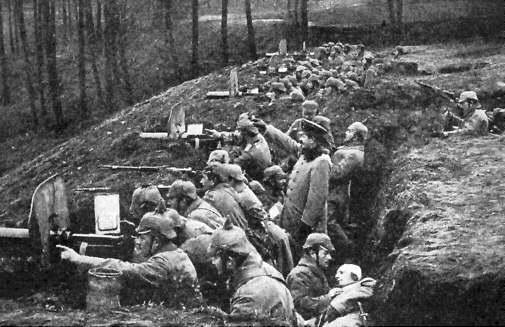
The 26 of August was threatened on both flanks of the Russian 2 Army. However, the Russian command has not yet realized the full extent of the threat. The offensive of the two Russian armies in East Prussia was still evolving. So, on August 27, the commander of the 2 th Samsonov ordered the 6 Army Corps to go to Allenstein to support the central corps, leaving the barrier behind Bischofsburg. He did not even know that the 6 Corps had already been defeated and retreated, exposing the right flank of the Russian army.
The German command set the following tasks for the corps commanders on August 27: Francois's 1 corps was to continue to attack Usdau and Neidenburg; The 20 Corps of Scholz to advance in the same direction; 3-I reserve division to roll on Waplitz; 1-th reserve and 17-th corps finally defeat the Russian troops in the area of Bischofsburg.
Fights 27 August
The main events of this day took place on the left flank. On the left flank of the 2 Army, where the defense was held by the Russian 1 Army Corps, which was stationed on the Usdau line, Gros-Taurze, Skurpe, there was a stubborn battle. Russian troops in the Usdau area came under cross artillery fire from the north-east — from the side of Bergling, from where they were attacked by serf artillery, and from the west (from the front) where they fired with artillery from the 1 German Corps. Under heavy shelling, Russian troops at about 11 hours moved away. Their positions were taken by the 1-I German division. The Russian troops repulsed the attack of the 2 Division, which was advancing on the left flank on Gros Taursee. In the area of Henrichsdorf, the attack of the Mühlmann brigade was repelled.
While the Germans were regrouping forces and were preparing for a new strike on Neidenburg, the Russian troops launched a counteroffensive in the area of the settlements of Skurpe and Henrichsdorf. Russian soldiers crushed the right flank of the German 1 corps. By evening, the entire German flank had fled.
Thus, all the initial successes of the Corps of Francois on the left flank of the 2 Army were eliminated. Unfortunately, the commander of the 1 Corps was unable to take advantage of this success to introduce additional forces into the breakthrough and crush the enemy corps, which led to the destruction of the German 8's right wing and the collapse of the plans to reach the Russian army from both sides. As a result, the counterattack ran out of steam. The Russian troops, believing that they had completed their task, threw the enemy back, began to retreat to their previous positions and further. The troops moved south to the river. Neide, north of the Neidenburg line, Soldau. Moreover, the withdrawal led to disorganization, disorder. Because of the confusion with the command of the Corps Artamonov was replaced by Dushkevich, the command and control was bad.
It did not take into account the possibility of a decisive attack on the left wing and the command of the 2 Army, leaving only one corps to cover the left flank. With large forces in this direction, the outcome of the battle could be different. In the center, the Russian 6 Infantry Division of the 15 Corps occupied Mühlen, but without reserves, could not build on success.
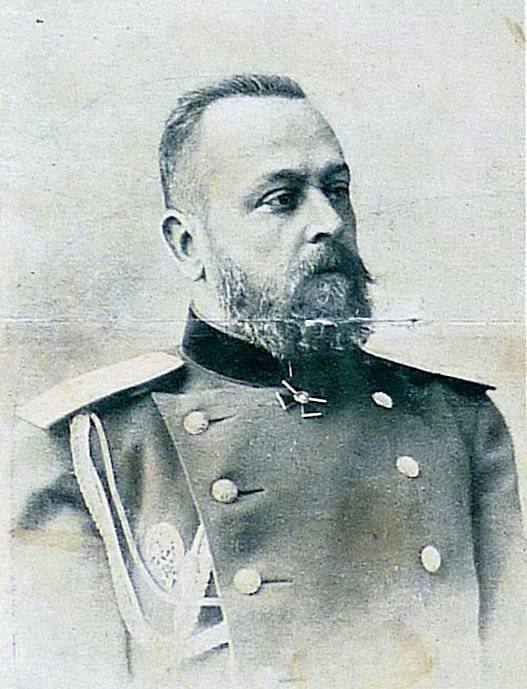
Commander of the 2 Army during the East Prussian operation, cavalry general Alexander Vasilyevich Samsonov
Fights 28-29 August
At night, the German troops on the right flank recovered from the defeat. The German 1 Corps began to move, occupying the positions left by the Russian troops. With the departure of the Russian 1 of the Army Corps south to the river. Neide, north of the Neidenburg line, Soldau, until the left flank of the 15 Corps, there were no more Russian troops. Therefore, the German troops were able to attack in the Neidenburg area or to cover the left flank of the 15 corps with a blow to Waplitz. In addition, the 2-I Russian division of the 23-Corps, which lost its combat capability due to previous battles, moved to Frankenau and beyond.
As a result, the Russian 1 Army Corps was not defeated, and in fact, he cleared the way for the enemy. The path to cover the left flank of the 15 and 13 of the Russian corps was opened for the German troops. The Russian 15 and 13 corps could now save the order to withdraw to the Neidenburg, Ortelsburg line or further to the border. However, they did not receive such an order. Because of the inept organization at the front, the army and the corps, the 2 Army was in danger of being killed. And the success of individual Russian units, like Mühlen’s 6 Division and the heroic self-sacrifice of Russian soldiers, their valor, meant nothing.
28 August Samsonov, receiving false messages and not knowing the depth of the 1 Army Corps retreat, gave him the order to hold positions north of Soldau, units of the 2 Division at Frankenau. The 6 Corps was to go to Passenheim. The 13 and 15 corps received the mission to advance through Mühlen on Gilgenburg. They were to go to the flank and rear of the German troops, who attacked the 2 division and the 1 corps. This offensive, taking into account the withdrawal of troops of the 1 of the Russian corps, only facilitated the adversary's environment of the 13 and 15 corps.
The Russian front command only on that day realized its mistake when it hurried the 2 army forward, not knowing the whole picture, without supporting the advance of Samsonov by the reserves and the 1 army of Rennenkampf. The realization has come that the Germans are not running beyond the Vistula, but are developing the offensive! Zhilinsky ordered the army of Samsonov's army to withdraw to the line Ortelsburg, Mlava. But, by another fatal coincidence, Samsonov had already left his headquarters in Neidenburg, having gone to the front, to the position of the 15 corps. Therefore, the order of the commander did not reach the command of the army. Since that time, the army lost its unified command. The messengers with the reports searched in vain for the commander, and he lost contact with the front command, corps and rear. The collapse of the management killed any chances of minimizing losses.
The front command also ordered the 1 Army to immediately help Samsonov. Connections army Rennenkampf made without delay, 28 August. But they were obviously late - there was a gap between the armies in 95 km.
Meanwhile, the 28 in August, the German 1 Infantry Division of the 1 Corps, occupied Neidenburg, and the Smetaw detachment occupied Mushaken. In Neidenburg there was a wagon train, an infirmary. Here was the commander of the 23 Corps Kondratovich with one brigade. This was enough to hold the enemy and send for reinforcements. However, General Kondratovich left his troops and fled to Prasnysh (he was removed from his post).
However, the offensive of the German 41-th division in Waplitz failed. Reach the flank and rear of the Russian 15 body did not work. Exhausted by marches and battles, half-starved Russian troops stood firmly and successfully counterattacked. The German 41 Division suffered a defeat, losing 2400 man and 13 guns.
Source: Kolenkovsky A. The Maneuverable Period of the First World Imperialist War 1914
Death of 13 and 15 cases. 2 Army Retreat
The attacking actions of 28 in August of the 15 and 13 of the corps did not have decisive success, therefore in the second half of the day Samsonov gave the order to withdraw to Yanov. Meanwhile, the German 1-th reserve and 17-th corps quickly approached the battlefield. By the evening of August 28, the 1-I reserve division of the 1-second reserve corps reached Daraten. On the morning of August 29, the troops of the 17 Corps moved to Brazier, Malga and Malgaofen, intercepting the withdrawal routes of the Russian troops to the east and southeast. At the same time, units of the 1 Corps and the Smetaw detachment occupied Pucholen, reached Wilenberg, cutting off the withdrawal routes of the Russian troops to the south.
Thus, two Russian corps fell into the ring of encirclement. The tragic agony of the Russian troops began. The Russian 13 Corps of Klyuev did not yet know about the catastrophe. Russian soldiers entered Allenstein, the second largest city in East Prussia. There was no news about the neighbor on the right, the 6 case. They received a radiogram from there, but this time it was encrypted, they failed to translate. Aerial reconnaissance detected the movement of troops from the east, but decided that it was their own. According to the order of Samsonov, Klyuev moved his troops to the offensive in the general direction of Gilgenburg. In the city left two battalions. The German corps of von Belov crushed the Russian battalions instantly. In addition, the “peaceful citizens” had recently struck the rear of the Russian battalions. The Germans moved on.
Klyuev, considered that these were small enemy forces and put up an incomplete Dorogobuzh 143 Infantry Regiment against them (one battalion was defeated at Allenstein). The regiment was left without artillery and ammunition (carts left with the body). A whole corps fell upon the Russian soldiers. However, the dorogobuzhtsy occupied the defile between the lakes, the enemy could not reach them, to attack with all their might. Russian soldiers fought off machine guns while they were loaded with ammunition. Then they greeted the Germans with bayonets. The regiment with bayonet counterattacks kept the enemy until evening. His commander Vladimir Kabanov fell. The battalions were heavily thinned, but they stood. Only in the dark did the remnants of the regiment took off and went to look for their own.
Meanwhile, Martos' 15 Corps fought against Mühlen. In the evening of August 28 Samsonov arrived here. Assessing the situation, he allowed the withdrawal to Neidenburg. However, for the withdrawal, the army headquarters adopted an overly complicated “sliding shield” scheme, when the units in turn moved from the northern end of the front to the southern one. First there were transports, then the 15 corps and at the end of the 2 division of the 23 corps. Martos with the corps headquarters was to leave for Neidenburg and select positions for defense. As a result, the most combat-ready corps was beheaded. Samsonov himself left. Organize a retreat instructed Klyuev.
This decision was also made due to lack of information. About the environment did not yet know. Under these conditions, the troops could only be saved by a breakthrough by the main forces, the baggage had to be abandoned. German troops intercepted the withdrawal of the Russian corps by very weak forces, the encirclement was not tight. If Samsonov had retained control in his hands, then both Russian corps would undoubtedly break out of the encirclement of the main forces.
"Sliding shield" immediately collapsed. It was difficult to regulate the movement of troops without communication, in the forests and swamps, even in the conditions of an offensive, and such a situation was a complete mess. Parts retreated as necessary. The Germans tried to pursue them. But the 15 body was still combat-ready. Snarled violently.
Hindenburg after the heavy fighting at Mühlen in general was decided to abandon the idea of the environment. Push back Russian troops - and that's great! He ordered Scholz and Francois to pursue and drive out the Russians. Belov and Mackensen again had to turn against Rennenkampf’s 1 Army. However, these orders are late. The central buildings have already been surrounded.
Part of Samsonov's headquarters, which managed to get out of the ring of the environment, in the morning of August 29 reported to Zhilinsky that the army was retreating. Commander, decided that now the movement of the army Rennenkampf to the battlefield senseless and ordered to suspend the movement of the corps. However, the commander of the 1 Army continued to move his army "in view of the heavy fighting of the 2 Army."
Indeed, the Russian warriors continued to desperately resist. In the area of Hohenstein, an unequal battle was launched by the rearguard of the Klyuev 13 Corps — the Kashira 144 and Narva 3 infantry regiments. Russian units were surrounded, their 16 guns fought 86 with German guns. The soldiers fought until the evening. In the last fight, the commander of the Kashirsky regiment, the hero of the Russian-Japanese war, Boris Kakhovsky, fell. Another Russian rearguard, the Sofia 2 Infantry Regiment, met the enemy between two lakes near the village of Shvedrekh. The Russian soldiers fought violently, the regiment thinned out, but survived. His remnants moved away. Hindenburg, in an August 30 conversation with the German main headquarters, noted that the Russians are holding "incredibly hard."
The German encirclement ring was weak, it was quite possible to pass. The Germans blocked the most important paths with small barriers. However, General Klyuev decided "to avoid unnecessary bloodshed" to surrender. Those who did not want to give up, could break further. Part of the troops separated and went on a breakthrough, most of these soldiers got out. Someone chose to die in battle, occupying all-round defense. Others, exhausted by marches and starving, lost heart and obeyed the decision of the command.
Martos, actually sent to his death in front of his troops, ran into a German patrol with several satellites. During the shelling, a horse was killed under him, the general himself was captured. Samsonov fell into the chaos of retreat. He tried to lead a detachment of retreating troops, but realizing that it was already impossible to regain control, he fell into prostration. He told others: “The king trusted me. How will I meet him after such a defeat? ”Despair led him to suicide. The general committed suicide on the night of August 30. The officers, who left the encirclement with Samsonov, soon came out to their own.
It should be noted that during this operation the Germans did not show their best. Military psychosis did the trick. On the remaining encirclements, a real hunt was conducted, to which policemen, huntsmen, volunteers with dogs joined. Seriously injured, shot sanitary units and hospitals. The prisoners were tortured, beaten, harnessed to guns, instead of horses.
In the evening of August 29, the catastrophe picture began to appear for the front command. They sounded the alarm. Rennenkampfu was ordered to push the cavalry to Allenstein. And 1-th and 6-th corps of the 2-th army, which remained outside the ring of the environment to organize counter-attacks on the flanks. However, their command failed the whole thing. The commander of 6 Corps Blagoveshchensky was afraid that the Germans would strike at him with all their might, he allocated only a small Nechvolodov detachment for the operation. In the 1 Corps, Artamonov, Dushkevich and Mosalsky decided which one was the boss. After the pressure of command, the Warsaw Guards Division of General Cirelius was singled out.
Even these sluggish actions showed all the weakness of the Germanic ring of encirclement. A squad Nechvolodova knocked the enemy out of Willenberg. This attack helped out of the encirclement of the cavalry surrounded corps. Sirelius knocked over small German barriers and took Neidenburg. The Germans almost started to panic. Only reported on the victory and there is such an incident. They pulled five divisions, and pushed aside the guards. Nechvolodov also received an order to retreat. But, their attacks showed that the Russian troops could do with a more skillful and decisive command.
At this time, the troops of Rennenkampf successfully attacked, knocking over the German cavalry and parts of the landsturm. By August 31 Russian troops reached the closest approaches to Konigsberg, occupied Friedland. Cavalry Corps entered Allenshteyn. Zhilinsky told Rennenkampf that Samsonov's army was defeated, and ordered the return of cavalry from the raid. However, this raid caused a lot of noise in the German rears. False alarms were raised - “Russians are coming!” They opened “friendly fire on their own, there were victims.
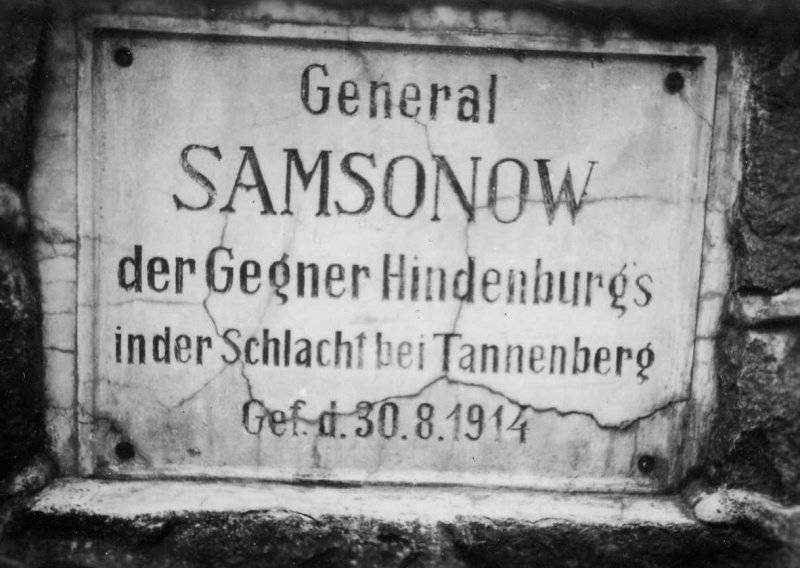
A plaque on the site of the death of the general of the Russian army Samsonov. The monument in memory of the Russian military leader was established in the 1918 year by the former opponent A.V. Samsonov - German general Hindenburg. On the blackboard there is an inscription in German: “To General Samsonov, the opponent of Hindenburg in the Battle of Tannenberg, 30 in August 1914 of the year”.
Results of the Battle of Tannenberg
The threat of encirclement and defeat of the German 8 Army was eliminated. The Russian 2 Army suffered a heavy defeat. 31 August Zhilinsky ordered the troops to withdraw beyond the river Narev. The remnants of the Russian 15-th, 13-th corps and 2-th division, which broke out of encirclement, moved to the Narev River in the area of Ostrolenka. They began to put in order.
German propaganda excessively inflated the scale of this victory, announcing the death of the entire 2-th Army of Samsonov. 70 — 90 of thousands of prisoners and 20 of thousands of Russians killed, 300 — 600 of captured guns were reported. Real losses were less. About 60 thousand people were killed, injured and captured, the Germans got 200 guns (some were damaged in battle or disabled by gunners). Killed 10 generals, 13 captured. Around 20, thousands of surrounded soldiers could pass to their own. German losses - about 30 thousand people (according to other sources - about 40 thousand people).
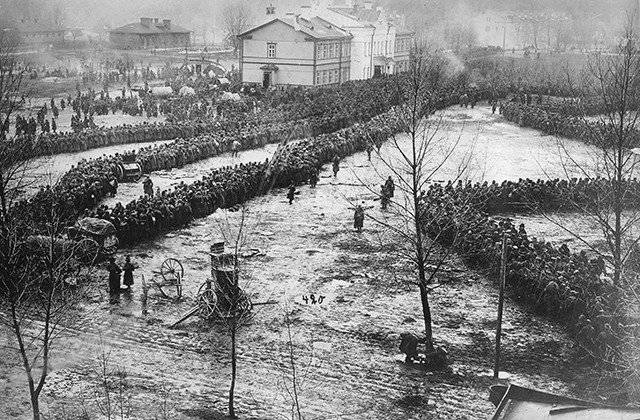
Captured Russian soldiers
Causes of defeat
According to researchers, there are several main factors that led to the defeat. There is an absolutely disgusting command at the front-army-corps level. Some Russian divisions and regiments won a number of important victories at Lahn, Orlau, Frankenau, Vaplitsa, Mühlen, etc., but the individual successes of the Russian troops were not linked into a common victory. German troops suffered a series of tactical defeats, but won the operation as a whole. The Russian flanks were pushed aside, and the center of the army was destroyed.
First, the main part of the blame lies on the high command, which, due to political considerations, has hurried the Russian armies, which began the offensive before the completion of the concentration of all forces, the conduct of reconnaissance in force and the organization of the rear.
Secondly, the leadership of the headquarters of the North-Western Front was completely unsatisfactory. Zilinski and his headquarters could not correctly assess the operational situation in the period of August 20-26, substituting almost the entire German 2 army, which was considered defeated and retreating beyond the Vistula, to the 8 th army.
Thirdly, these are the mistakes of the commander of the 2 Army, General Samsonov, who could not competently dispose of the troops entrusted to him, to organize a counter battle. An unsatisfactory assessment can be made to most of the corps commanders — Artamonov (1 corps), Blagoveshchensky (6 corps), Klyuev (13 corps), Kondratovich (23 corps).
Most modern researchers (in Soviet historiography, blamed for the death of Samsonov’s army on Rennenkampf) believe that the mistakes of the command of the 1 Army were not decisive in the general defeat.
Fourth, the poor performance of the Russian army intelligence, which failed to reveal the concentration of the main forces of the German army against the flanks of the 2 army, played a major role in the defeat. Until the very last moment, the command of the army believed that it was leading a battle with enemy barriers and retreating forces. You can also note the complete disregard of the front radio communications rules, the enemy received all the plans of the 2-th army on intercepted telegrams.
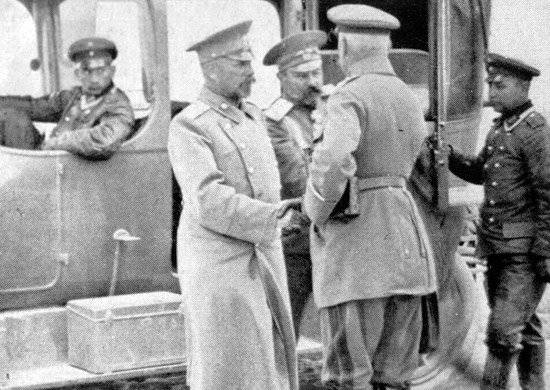
The commander of the German 1 Army Corps, General of the Infantry, Francois, meets the captured Russian Lieutenant General Klyuev 18 (31) August 1914 g.
The retreat of the 1 of the Russian army from East Prussia
Berlin has retained East Prussia. September 4 Hindenburg received an 2,5 corps from the Western Front. The German army regrouped its forces and came out against the Russian 1 army. In the southern direction, a barrier of one and a half divisions was left, seven corps and two cavalry divisions were sent against Rennenkampf (230 thousand soldiers with 1080 guns). The 2 Army had five corps and five cavalry divisions (110 thousand people with 900 guns).
In this case, the main forces of the Russian army were located on the Koenigsberg direction. Therefore, the German command decided to strike at the left flank of the 1 Army, where there was only one corps and part of cavalry. Three corps and two cavalry divisions were sent through lake defiles to Lettsen bypassing the Russian southern flank, and four corps to the north of the lakes. The German headquarters planned to break through the front on the left flank and go to the rear of the Russian army.
September 7-9 German roundabout completed its task. Rennenkampf redeployed reserves to the south to hold back the enemy and began to divert the main forces of the army to the east. As a result, the threat of encirclement was eliminated. In addition, in the southern direction, September 10 launched an offensive on the 2 Army allegedly "destroyed" in the Battle of Tannenberg. Hindenburg and Ludendorff had to transfer part of the troops to the south. By 14 September, the 1-I army retreated in an organized manner beyond the Neman. Departure covered 2 th and 20 th corps. The German plan to encircle and destroy the 1 army failed. By September 15, the East Prussian operation was completed.
General results
The Russian armies returned to their initial positions on the Narev and Neman rivers. During the operation, the troops of the North-Western Front lost about 80 thousand men and 500 guns. The Germans lost more than 53 thousand people. The plan to encircle and destroy or oust the 8 of the German army failed. It was not possible to occupy East Prussia. In addition, the Russian Stavka had to ease the pressure on the Austro-Hungarian Empire, transferring reserves to restore the 2 Army, which was why it was not possible to fully develop success in Galicia. Also, the plans for an offensive from the Warsaw salient through Poznan against Berlin were not realized; this operation was to begin after success in East Prussia.
German 8-I army decided to defend Prussia. The Germans were able to regroup after defeat in Gumbinnen, defeated the 2 Russian army in the Battle of Tannenberg, displaced the 1 Army for the Neman. It was a significant success for Germany on the Eastern Front.
However, the difficult situation of the German army 8, whose command was not confident of success and even initially wanted to retreat beyond the Vistula, forced the main headquarters to change the leadership of the army and transfer 11 and reserve Guards corps with a cavalry division to the East, which seriously helped the French army in the battle of Marne. The victim of Russian soldiers saved France from a serious defeat. The war became protracted, and in such a war the Entente powers had more chances to win. In addition, the German army was unable to assist the Austro-Hungarian troops, who at that time were defeated in the Battle of Galicia.
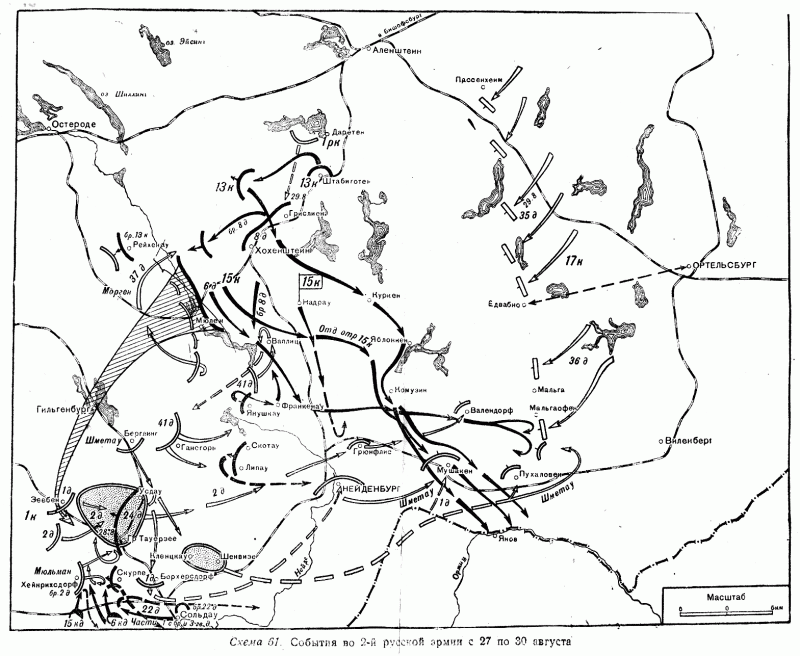
Information